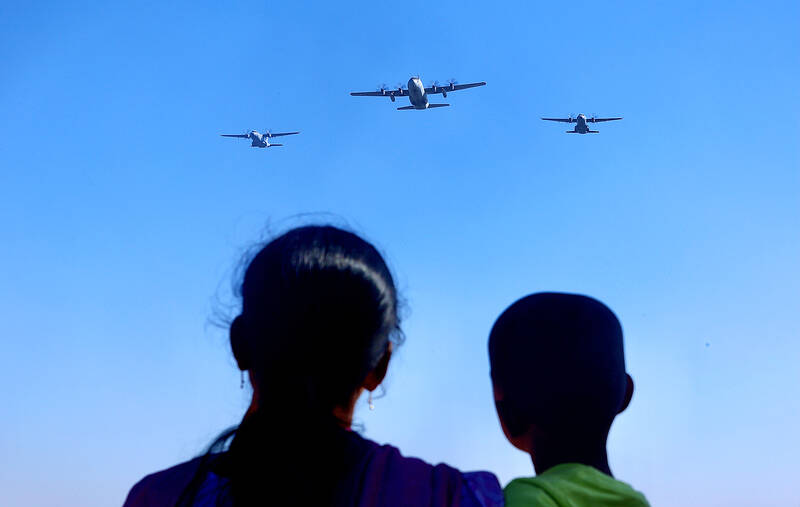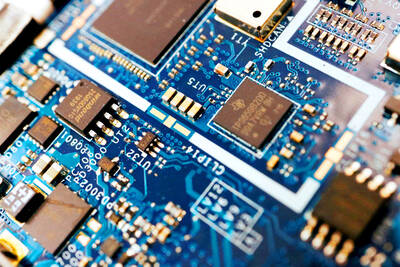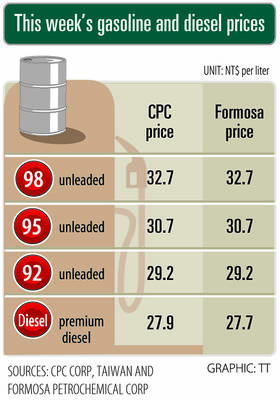Air traffic is booming in India, even though only a tiny fraction of its people fly each year, and manufacturers are seeking lucrative deals at the flagship Aero India exhibition from tomorrow.
The International Air Transport Association would also hold its annual general meeting in June in New Delhi, the capital of the world’s fifth-largest economy, another clear sign of India’s market punch.
The sustained growth of its economy and middle class have made India and its 1.4 billion people the third-largest air market in the world, after the US and China.

Photo: EPA-EFE
“India is the rising star of global aerospace,” Airbus India president Remi Maillard said. “It is the fastest-growing commercial aviation market in the world — and it would remain so for the next 20 years.”
Airbus rival Boeing, which would also take part in the five-day Aero India show in Bengaluru for global aero vendors organized by the Indian Ministry of Defence, is equally enthusiastic.
“It’s the most dynamic market on the planet — and certainly the most exciting,” Boeing India president Salil Gupte said.
The Indian Ministry of Civil Aviation boasts of “soaring skies” in a sector “experiencing a meteoric rise.”
That growth should lead to an increase in traffic in South Asia, mainly in India, of more than 7 percent per year until 2043, according to Boeing’s forecasts.
“Per capita air travel remains low in India at a mere 0.12, compared to 0.46 in China,” Maillard said, calling it a “telling comment on the potential of the Indian aviation market.”
Railways remain hugely popular, but traveling by trains crisscrossing a country about three-quarters the area of the EU is often slow and chaotic.
Boeing estimates that it would take about 2 percent of the 18 million daily train users — compared with 430,000 air passengers — to switch to flying for the air market to double.
Indian Prime Minister Narendra Modi has made the development of the air sector a priority since coming to power in 2014.
Modi, who has said he wants to “bring air travel to the common people,” began a plan in 2016 to boost air links between small towns and the country’s megacities.
“A common man who travels in slippers should also be seen in the aircraft — this is my dream,” Modi was quoted as saying by the aviation ministry.
The number of airports has more than doubled in the past decade — from 74 in 2014 to 157 last year, according to Indian Ministry of Statistics and Programme Implementation figures.
The Indian government is pouring in millions of dollars and is promising to increase the numbers to between 350 and 400 by 2047, the centenary of India’s independence.
At the same time, the government has opened programs to train about 30,000 pilots and at least as many mechanics over the next 20 years.
Airbus and Boeing are key partners in that, with an emphasis on promoting women.
The major manufacturers say the next leap in the airline sector in India would be international.
“The kind of revolution we have seen in the Indian domestic market in the last few years is now happening in the long-haul market,” Maillard said, adding that Airbus was “leveraging India’s locational advantage, demographic dividend and economic growth.”
Gupte said Boeing was expecting more orders for large aircraft capable of long-haul flights, which he believes would make up 15 percent of India’s total fleet within the next 20 years.
Boeing forecasts that the Indian market would need at least 2,835 new aircraft by this deadline — three-quarters for market growth, and the rest as replacement.
For Airbus, India made up nearly one-tenth of its global commercial aircraft delivered last year — 766 commercial aircraft in total to 86 customers, with 72 going to Indian carriers.
Boeing, which was shaken by scandals related to the production quality of its aircraft and slowed down by a strike, has not released figures for last year.
Neither aircraft manufacturer wanted to detail its ambitions for the Aero India show.
However, India’s order basket is overflowing.
Air India, after a giant 2023 contract for 470 aircraft — 250 Airbus, 220 Boeing — ordered 100 more Airbus planes last year.
India’s largest carrier, low-cost airline IndiGo, is also not satisfied at having placed the largest order in volume in the history of civil aviation — 500 from Airbus in 2023.
It ordered 30 more last year.

Hon Hai Precision Industry Co (鴻海精密) yesterday said that its research institute has launched its first advanced artificial intelligence (AI) large language model (LLM) using traditional Chinese, with technology assistance from Nvidia Corp. Hon Hai, also known as Foxconn Technology Group (富士康科技集團), said the LLM, FoxBrain, is expected to improve its data analysis capabilities for smart manufacturing, and electric vehicle and smart city development. An LLM is a type of AI trained on vast amounts of text data and uses deep learning techniques, particularly neural networks, to process and generate language. They are essential for building and improving AI-powered servers. Nvidia provided assistance

DOMESTIC SUPPLY: The probe comes as Donald Trump has called for the repeal of the US$52.7 billion CHIPS and Science Act, which the US Congress passed in 2022 The Office of the US Trade Representative is to hold a hearing tomorrow into older Chinese-made “legacy” semiconductors that could heap more US tariffs on chips from China that power everyday goods from cars to washing machines to telecoms equipment. The probe, which began during former US president Joe Biden’s tenure in December last year, aims to protect US and other semiconductor producers from China’s massive state-driven buildup of domestic chip supply. A 50 percent US tariff on Chinese semiconductors began on Jan. 1. Legacy chips use older manufacturing processes introduced more than a decade ago and are often far simpler than

STILL HOPEFUL: Delayed payment of NT$5.35 billion from an Indian server client sent its earnings plunging last year, but the firm expects a gradual pickup ahead Asustek Computer Inc (華碩), the world’s No. 5 PC vendor, yesterday reported an 87 percent slump in net profit for last year, dragged by a massive overdue payment from an Indian cloud service provider. The Indian customer has delayed payment totaling NT$5.35 billion (US$162.7 million), Asustek chief financial officer Nick Wu (吳長榮) told an online earnings conference. Asustek shipped servers to India between April and June last year. The customer told Asustek that it is launching multiple fundraising projects and expected to repay the debt in the short term, Wu said. The Indian customer accounted for less than 10 percent to Asustek’s

Gasoline and diesel prices this week are to decrease NT$0.5 and NT$1 per liter respectively as international crude prices continued to fall last week, CPC Corp, Taiwan (CPC, 台灣中油) and Formosa Petrochemical Corp (台塑石化) said yesterday. Effective today, gasoline prices at CPC and Formosa stations are to decrease to NT$29.2, NT$30.7 and NT$32.7 per liter for 92, 95 and 98-octane unleaded gasoline respectively, while premium diesel is to cost NT$27.9 per liter at CPC stations and NT$27.7 at Formosa pumps, the companies said in separate statements. Global crude oil prices dropped last week after the eight OPEC+ members said they would